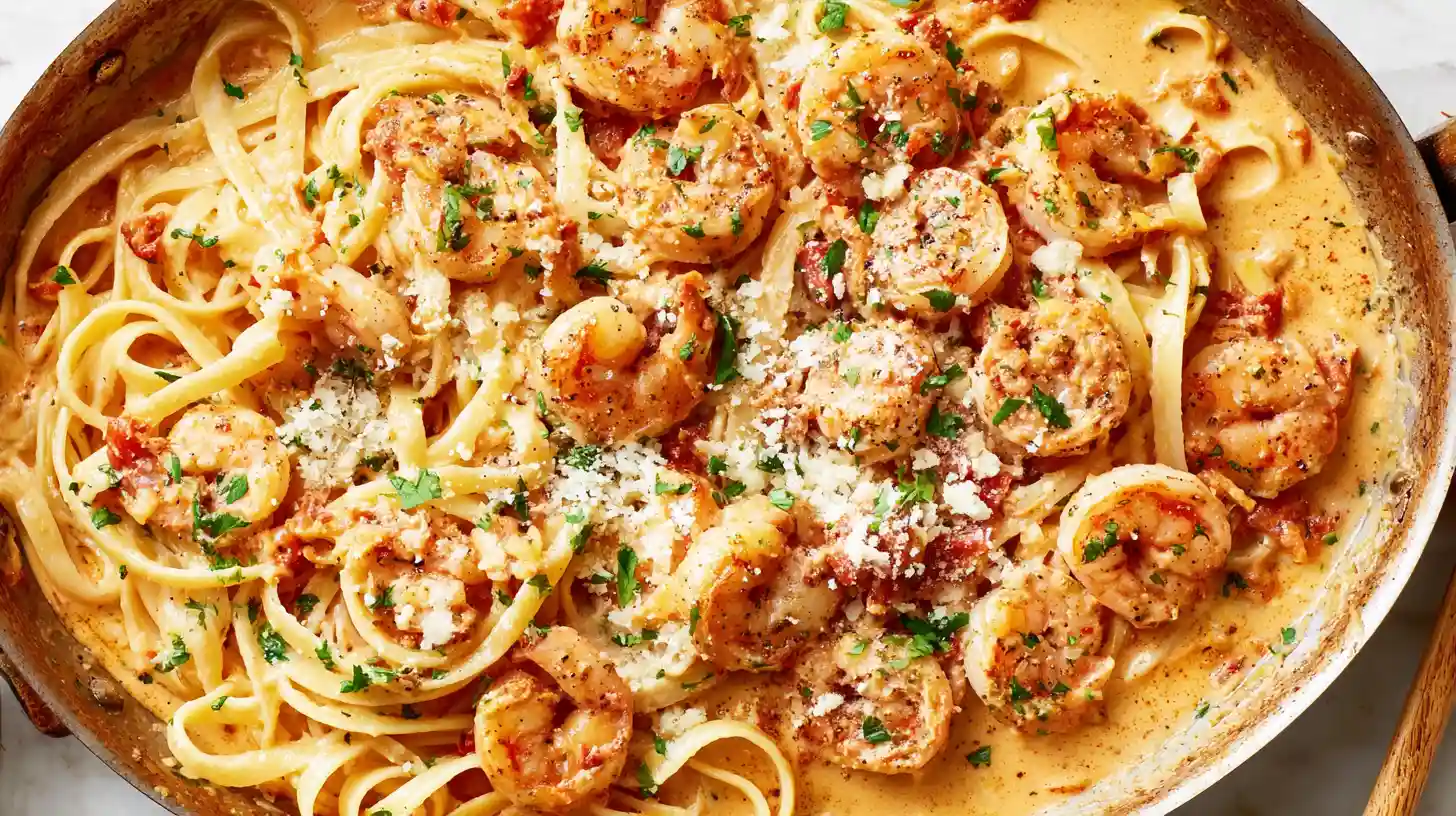Cajun Shrimp Pasta is a creamy, spicy, and deeply flavorful dish that combines seared shrimp, garlic, and Cajun spices in a luscious sauce. It is fast enough for weeknights yet indulgent enough to serve guests. This guide gives you every variation you could want, from the classic creamy version to smoky sausage, lighter no-cream, Alfredo, and even a cast-iron skillet method.
The appeal of Cajun Shrimp Pasta lies in its contrast. The sauce balances buttery richness with a bright finish from lemon juice, and the spice warms without overwhelming. If you love simple comfort with restaurant-quality texture, this recipe will deliver consistent results every time.
You can pair this dish with sides such as the Refreshing Cucumber Tomato Salad or a slice of Sweet Potato Bread for a balanced meal. For those who enjoy similar seafood comfort dishes, try the Shrimp Orzo Recipe next time for a lighter pasta option.
This guide is designed to outperform competing recipes by offering a complete master version that satisfies all user intents in one place. It will help readers cook a creamy base, adapt it for health or authenticity, and understand exactly how to fix common problems like runny or oily sauce.
What Is Cajun Shrimp Pasta? (Quick Overview)
Cajun Shrimp Pasta is a 30-minute skillet meal where tender shrimp, garlic, and Cajun seasoning combine with a creamy Parmesan sauce and pasta water to create a glossy, spicy coating. Add sausage for smokiness, or lighten it with milk and cream cheese for a healthier version.
[Visual suggestion: Overhead photo of creamy penne twirled with shrimp, Cajun spice flecks, lemon wedge, and chopped parsley on a light neutral plate.]
Cajun Shrimp Pasta Ingredients Explained (Creamy Cajun Alfredo Style)
Each ingredient in Cajun Shrimp Pasta plays a specific role in building flavor, texture, and balance. Understanding how they work together ensures consistent results every time you cook.
Shrimp:
Use large raw shrimp for the best texture. They should be peeled, deveined, and patted dry before seasoning. Avoid pre-cooked shrimp because they can easily become rubbery. Fresh shrimp deliver a sweet, briny flavor that defines the dish.
Cajun Seasoning:
The heart of the recipe. A balanced mix of paprika, garlic powder, onion powder, oregano, thyme, cayenne, salt, and pepper adds warmth and complexity. You can create your own blend using the quick homemade recipe later in this guide.
Butter and Olive Oil:
Combining fats gives both richness and temperature control. Butter brings flavor, while olive oil prevents burning when searing shrimp.
Garlic and Bell Peppers:
These build aromatic depth and sweetness. Minced garlic should be sautéed briefly to prevent bitterness. Bell peppers, while optional, add texture and color contrast.
Cream and Parmesan:
Together, they create the smooth and glossy body of the sauce. The cream forms the base, while the cheese thickens and provides a nutty, salty edge. Always use freshly grated Parmesan; pre-grated cheese often contains starches that prevent proper melting.
Pasta and Pasta Water:
Al dente pasta retains bite and helps absorb the sauce. The starchy pasta water emulsifies the butter, cream, and cheese, giving a silky finish. Reserve at least one cup before draining.
Lemon Juice and Parsley:
These finishing touches brighten the sauce and cut through the richness. Lemon also balances the spice from Cajun seasoning.
If you love working with simple ingredients that turn into restaurant-quality meals, check out our EVOO Food Guide to understand how high-quality olive oil elevates flavor in quick dinners like this one.
For reliable information about seafood storage and handling, refer to the FDA’s seafood safety page for official guidance.
Outbound link 1 of 3: FDA Selecting and Serving Seafood Safely
[Visual suggestion: Overhead image of neatly organized ingredients labeled individually. Include shrimp, pasta, garlic, cream, butter, Cajun seasoning, and lemon wedge in a light-toned setup.]
How to Make Cajun Shrimp Pasta (Step-by-Step)
Follow these simple steps to prepare a creamy, flavorful pasta with perfectly seared shrimp. This method takes about 30 minutes from start to finish.

Boil Pasta for Cajun Shrimp Alfredo Base
Bring a large pot of salted water to a boil. Add pasta and cook until al dente, following package directions. Before draining, reserve one cup of pasta water. This will help you adjust the sauce later.
Sear the Shrimp with Cajun Seasoning
Pat the shrimp dry and toss with one and a half teaspoons of Cajun seasoning, a small pinch of salt, and black pepper. Heat butter and olive oil in a large skillet over medium-high heat. Sear shrimp for about one to two minutes per side until pink and opaque, then transfer to a plate.
Sauté the Aromatics
Lower the heat to medium. Add minced garlic and optional diced bell peppers. Cook for thirty seconds to one minute, just until fragrant.
Build a Creamy Cajun Sauce
Pour in heavy cream and the remaining Cajun seasoning. Stir well and simmer gently for two to three minutes until the sauce thickens slightly.
Add Cheese and Emulsify
Whisk in Parmesan a handful at a time, stirring continuously. Add small splashes of reserved pasta water to loosen and emulsify the sauce. The goal is a smooth, glossy texture that clings to the spoon.
Toss Shrimp and Pasta Together
Add the drained pasta and shrimp back to the skillet. Toss everything gently until evenly coated. Adjust seasoning with salt, pepper, and a touch more Cajun spice if desired.
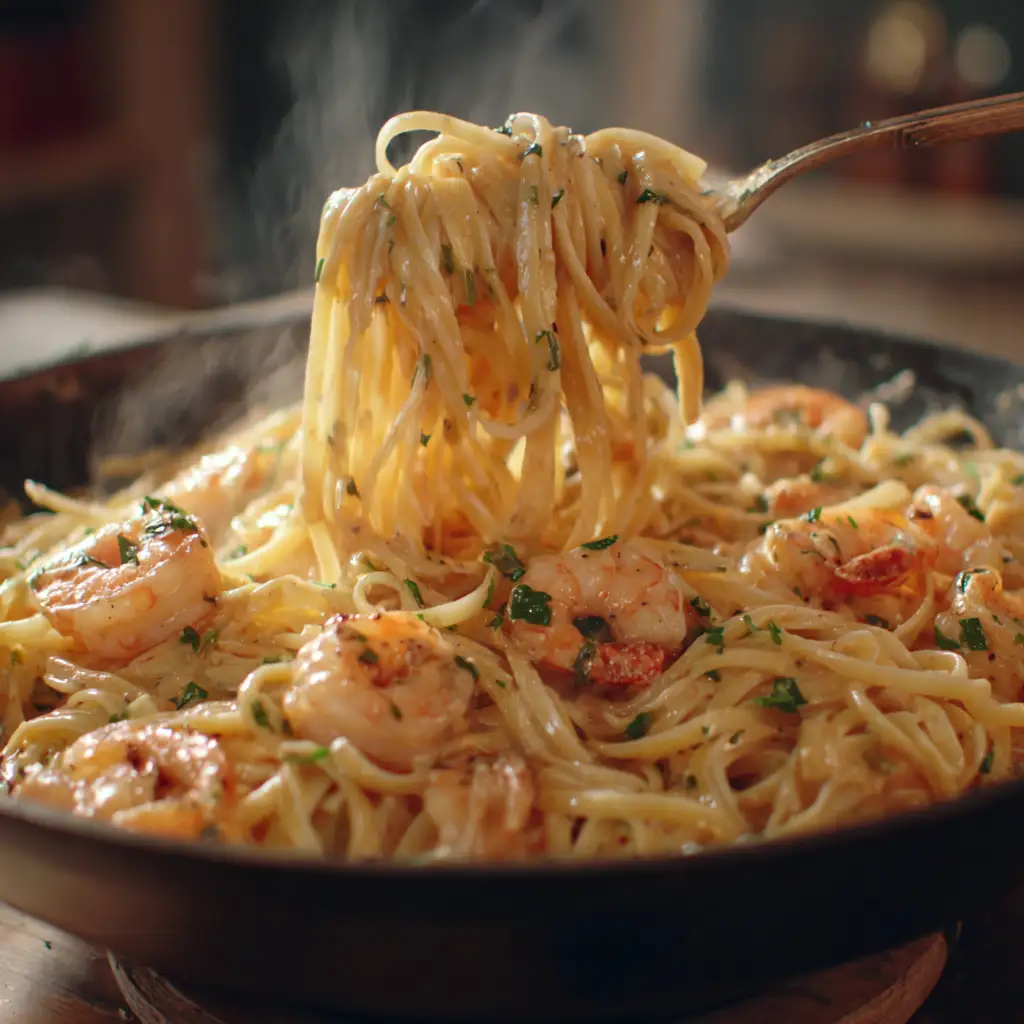
Finish and Serve
Remove from heat, stir in lemon juice, and sprinkle with chopped parsley. Serve immediately while hot.
If you enjoy one-pan meals, try the Ground Beef Stroganoff next. It follows a similar skillet method and delivers hearty comfort with simple cleanup.
For general food safety on proper seafood cooking temperatures, review the USDA Food Safety Education resource for accurate guidelines.
Pro Tips and Troubleshooting for Creamy Cajun Shrimp Pasta
Cooking Cajun Shrimp Pasta is simple, yet a few small details will elevate the result from home-cooked to restaurant-quality. Use these practical tips to refine your technique and fix common problems.
How to Prevent Overcooked Shrimp
Keep the skillet at medium to medium-high when searing shrimp. Too much heat can make them rubbery, while too little prevents a proper golden crust. Always remove shrimp as soon as they turn pink and opaque.
How to Fix a Runny Cajun Alfredo Sauce
If the sauce looks thin, let it simmer for another one to two minutes to reduce naturally. You can also whisk in a small handful of Parmesan to thicken without overpowering flavor.
Avoid a Broken or Oily Sauce
A sauce that separates usually means it was overheated or the cheese was added too quickly. Lower the heat, add a few spoonfuls of reserved pasta water, and whisk until smooth again.
Balance Spice and Salt
Cajun seasoning blends vary. Taste before adding salt, since many blends already include it. To mellow an overly spicy sauce, stir in one tablespoon of butter and an extra squeeze of lemon juice.
Time the Lemon
Add lemon juice only after removing the skillet from heat. The acidity brightens flavor and keeps the cream stable.
Texture Check
For the perfect creamy consistency, the sauce should coat the back of a spoon. If it feels too thick, whisk in another tablespoon of pasta water.
Make Ahead Tips
Boil the pasta in advance and store it lightly coated in oil. You can also pre-measure seasoning and grate the cheese ahead of time for faster weeknight prep.
If you like recipes that focus on balanced creaminess, the Creamy Parmesan Italian Sausage Soup offers a similar comforting base that pairs well with crusty bread or roasted vegetables.
For accurate recommendations on safe food cooling and reheating practices, consult our Food Safety Guidelines for Home Cooking.
[Visual suggestion: Two small photos side by side. One shows a runny sauce labeled “before reduction,” and the other shows the correct creamy consistency labeled “after emulsifying.”]
Cajun Shrimp Pasta Variations and Recipe Swaps
Cajun Shrimp Pasta is flexible enough to fit different tastes and dietary needs. These variations let you switch flavor profiles or lighten the meal without sacrificing satisfaction.
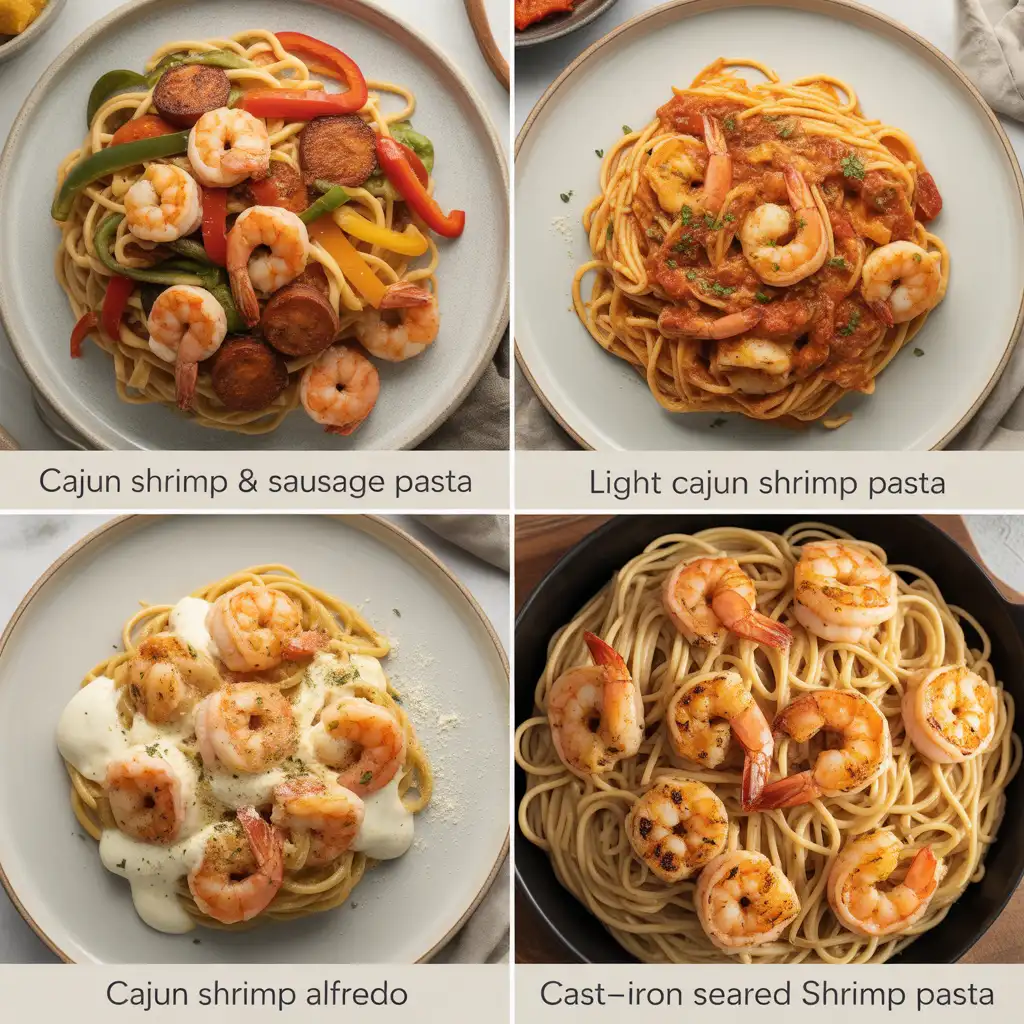
Cajun Shrimp Pasta with Sausage (Smoky Andouille Flavor)
Adding andouille sausage introduces a smoky depth that complements the Cajun spices. Slice the sausage into thin rounds, render it in the skillet before cooking the shrimp, and use the drippings to start your sauce. This method creates a deeper, bolder base. Serve it with a side of Roasted Red Pepper Gouda Soup for a cozy combination.
Healthy Cajun Shrimp Pasta without Cream
To make a lighter version, blend light cream cheese with milk and a few tablespoons of reserved pasta water. Warm the mixture gently before stirring it into the pan. This method mimics creaminess with less fat and fewer calories while keeping the Cajun flavor intact.
Cajun Shrimp Alfredo (Extra Creamy Version)
If you prefer a richer, cheesier pasta, this is your best option. Add an extra tablespoon of butter and another quarter cup of Parmesan when thickening the sauce. The result is smooth and luxurious, similar to a restaurant Alfredo but with Cajun spice.
Cajun Shrimp Scampi (Lighter, Garlicky Option)
This variation replaces the cream with a combination of lemon juice, and butter. Deglaze the pan after searing shrimp, scraping up the flavorful bits, and simmer for a minute before adding pasta. The result is lighter, aromatic, and slightly tangy.
Cast-Iron Skillet Cajun Shrimp Pasta Recipe
For a smoky edge and caramelized flavor, prepare this recipe in a cast-iron skillet. The shrimp develop a crisp sear while the sauce absorbs subtle roasted notes. If you love skillet cooking, you’ll also enjoy the Tex Mex Chicken Rice Skillet for another easy one-pan dinner.
Each version keeps the core Cajun flavor but offers a unique experience. You can alternate these methods through the week to enjoy the same base in different ways.
[Visual suggestion: A four-tile image collage showing each variation: sausage version, lighter no-cream, Alfredo style, and cast-iron method. Include small captions describing each flavor focus.]
What to Serve with Cajun Shrimp Pasta (Sides and Pairings)
Cajun Shrimp Pasta pairs best with sides that balance its creamy, spicy profile. Choose crisp salads, roasted vegetables, or light bread options to complete the meal without overwhelming the flavors.
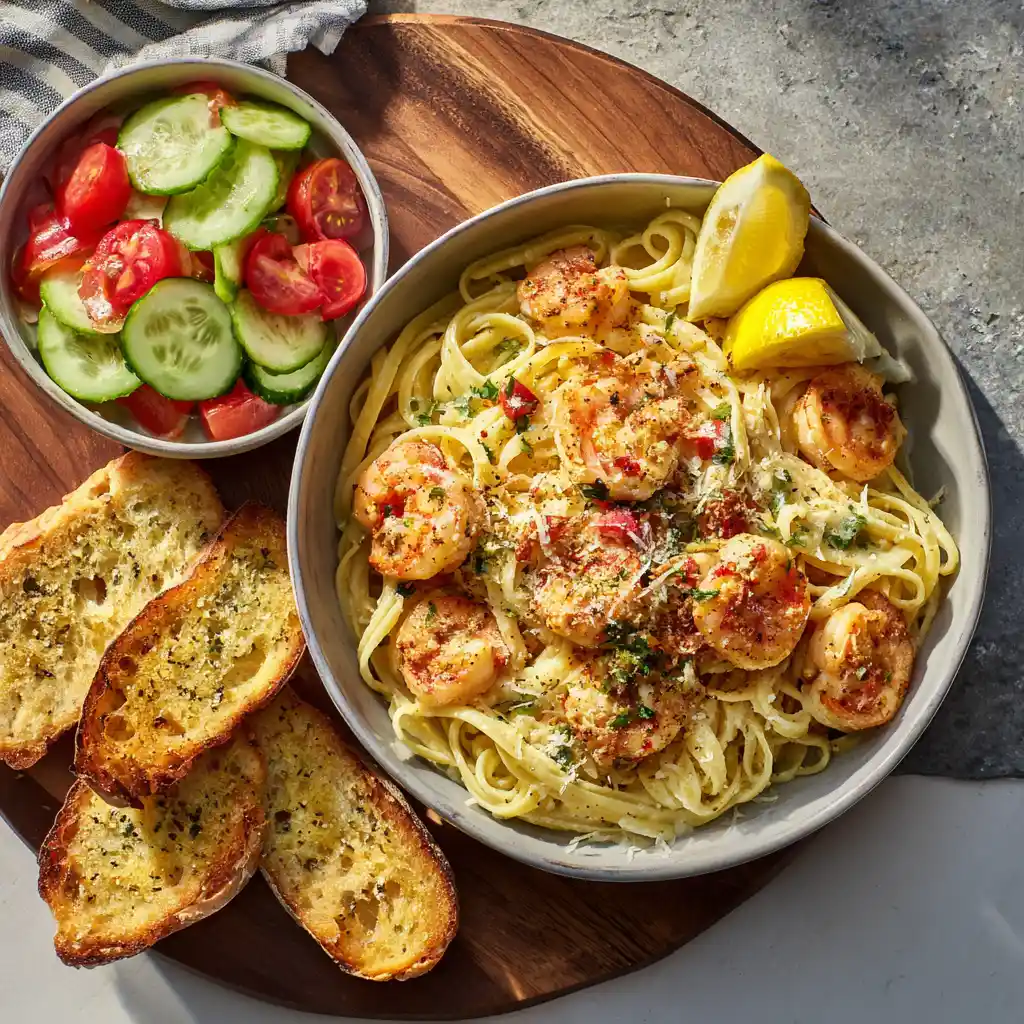
Fresh and Crisp Salads
A bright salad provides contrast and freshness. The Refreshing Cucumber Tomato Salad offers a cool, tangy counterpoint to the rich sauce. For more texture and variety, try the Mediterranean Chickpea Salad or mix a small bowl from our Healthy Salad Bowls collection.
Warm and Comforting Sides
Garlic bread or a slice of Sweet Potato Bread pairs well with the creamy sauce and helps soak up every drop. Roasted vegetables also make a balanced side, especially when seasoned lightly with olive oil and salt. The Crispy Roasted Sweet Potatoes add subtle sweetness that complements the spice.
Soup and Starter Ideas
For cooler nights, serve this pasta after a small bowl of Porcupine Soup or Creamy Parmesan Italian Sausage Soup. These soups share the same cozy, creamy comfort that ties perfectly with Cajun Shrimp Pasta.
Beverage Pairings
A sparkling water with lemon helps balance the heat. For a non-alcoholic option, the Homemade Yogurt Drink refreshes the palate and complements seafood-based dishes naturally.
Serving Tip
Keep portions moderate and sides light so the main dish remains the focus. Cajun Shrimp Pasta already provides balanced protein, carbohydrates, and fat.
[Visual suggestion: Serving board photograph featuring a plate of Cajun Shrimp Pasta alongside cucumber tomato salad, garlic bread slices, and a lemon wedge. Neutral, well-lit presentation for clarity.]
2-Minute Homemade Cajun Seasoning for Shrimp Pasta
Homemade Cajun seasoning adds bold flavor without relying on store-bought blends that can vary in salt or spice. This quick mix uses common pantry ingredients and takes less than two minutes to prepare.
Ingredients
- 2 teaspoons paprika (smoked or sweet)
- 1 teaspoon garlic powder
- 1 teaspoon onion powder
- 1 teaspoon salt
- ½ teaspoon dried oregano
- ½ teaspoon dried thyme
- ½ teaspoon black pepper
- ½ to 1 teaspoon cayenne pepper (adjust to taste)

Instructions
- Combine all ingredients in a small bowl.
- Mix well and store in an airtight container or spice jar for up to three months.
- Shake before each use to redistribute any settled spices.
This homemade blend allows you to control the salt level and adjust the heat for your preference. For a milder version, use less cayenne. To emphasize smokiness, add a pinch of chipotle powder or smoked paprika.
Sprinkle this seasoning over seafood, chicken, or roasted vegetables. It also enhances quick sauces such as the 3 Ingredient BBQ Sauce or pairs well with simple side dishes like Roasted Veggie Grain Bowl.
For more information on spice storage and safe seasoning practices, consult the USDA’s Home Storage of Spices and Dry Goods guidelines for best results.
[Visual suggestion: Mini recipe card image showing small bowls of individual spices with a wooden spoon and labeled jar of “Cajun Seasoning.” Neutral background for clarity.]
Frequently Asked Questions about Cajun Shrimp Pasta
Can I Use Frozen or Pre-Cooked Shrimp?
Yes. If using frozen shrimp, thaw completely, then pat dry before seasoning. For pre-cooked shrimp, add them only at the end to warm through gently without toughening. This preserves tenderness and prevents overcooking.
What Pasta Works Best for Cajun Shrimp Pasta Recipes?
Penne, fettuccine, or linguine work best because they hold the creamy Cajun sauce evenly. Short, ridged shapes capture more flavor. For a noodle-based alternative, try our Shrimp Lo Mein Recipe for similar texture but an Asian twist.
Why Is My Cajun Shrimp Pasta Sauce Runny or Oily?
Runny sauce often means too much liquid or insufficient simmering. Let the sauce reduce for one to two minutes. If it turns oily, lower the heat and whisk in a splash of pasta water to re-emulsify. Stirring in extra Parmesan helps restore creaminess.
How Can I Make Cajun Shrimp Pasta without Cream?
Replace heavy cream with light cream cheese and milk. This keeps the sauce velvety but lighter. The result tastes just as rich with fewer calories. Serve it alongside the Refreshing Cucumber Tomato Salad for a fresh balance.
Can I Substitute Chicken for Shrimp in This Cajun Pasta Recipe?
Yes, chicken works beautifully. Sear bite-sized pieces before making the sauce, then simmer briefly until cooked through. For another quick skillet idea, see Garlic Butter Chicken Bites, which uses a similar method.
What Sides Go Well with Cajun Shrimp Pasta?
Pair it with a crisp salad or roasted vegetables. The Mediterranean Chickpea Salad and Crispy Roasted Sweet Potatoes complement the spicy cream sauce perfectly.
How Should I Store and Reheat Cajun Shrimp Pasta Leftovers?
Cool leftovers quickly, then refrigerate in a shallow airtight container for up to three days. Reheat gently in a skillet with a tablespoon of milk or water to revive the sauce. Avoid overcooking shrimp when reheating.
Can I Freeze Cajun Shrimp Pasta?
Freeze the sauce separately from the pasta for best texture. Thaw overnight, reheat slowly, then toss with freshly cooked pasta and shrimp before serving.
For more food safety information, check FoodSafety.gov for official seafood storage and reheating guidelines.
Nutrition and Dietary Notes for Cajun Shrimp Alfredo Pasta
Cajun Shrimp Pasta provides a balanced mix of protein, carbohydrates, and healthy fats, making it both satisfying and energizing. Here’s how the nutritional profile and dietary options break down.
Estimated Nutrition per Serving (Classic Creamy Version)
- Calories: 560 to 650
- Protein: 28–32 g
- Carbohydrates: 36–40 g
- Fat: 28–34 g
- Fiber: 2–3 g
- Sodium: varies depending on Cajun seasoning used
These values are approximate and can vary based on pasta type, cheese, and added ingredients.
Healthier Adjustments
To reduce saturated fat, use light cream cheese and milk instead of heavy cream. You can also substitute part of the butter with olive oil for heart-friendly fats. For additional lean protein inspiration, explore our High Protein Breakfast ideas, which complement an active or balanced diet.
Gluten-Free Adaptation
Substitute traditional pasta with gluten-free versions made from rice, quinoa, or chickpeas. These alternatives maintain texture and work well with the creamy sauce.
Dairy-Free Option
Use full-fat coconut milk and a plant-based parmesan alternative. Add nutritional yeast for extra umami flavor.
Low-Sodium Version
Reduce added salt and make your own Cajun seasoning using the 2-Minute Homemade blend featured earlier. This gives you complete control over sodium content.
Nutrient-Boosting Add-ins
Stir in sautéed spinach, kale, or roasted bell peppers to add color, vitamins, and fiber. If you prefer lighter meals during the week, the Roasted Veggie Grain Bowl is another satisfying option that pairs beautifully with this pasta.
Balanced Pairing Tip
When serving Cajun Shrimp Pasta, include a crisp salad or a small bowl of Greek Yogurt Dressing on the side. The tangy flavor balances the richness of the pasta perfectly.
[Visual suggestion: Nutritional facts table displayed beside a small bowl of shrimp pasta and a glass of water with lemon. Keep layout simple, clear, and easy to scan.]
Restaurant and Catering Notes: Cajun Shrimp Pasta for Menus
Cajun Shrimp Pasta performs beautifully in restaurant or catering settings because it holds its texture, reheats well, and pleases a wide range of palates. The combination of creamy sauce and bold spices makes it a consistent crowd favorite.
Batch Scaling
To serve larger groups, multiply the ingredients by two or four. Cook pasta slightly under al dente so it finishes perfectly when reheated in sauce. Keep the sauce thicker initially; thin it with hot pasta water just before plating for a glossy, fresh finish.
Holding and Serving
For buffet or service lines, store pasta and sauce separately in covered pans over gentle heat. Toss portions to order so each serving looks freshly prepared. Garnish with parsley or grated Parmesan right before serving for a polished appearance.
Menu Ideas and Descriptions
On a menu, list it as “Creamy Cajun Shrimp Pasta with optional Andouille Sausage add-on.” Highlight the 30-minute preparation time and the choice between classic or lighter versions. This flexibility appeals to both casual diners and customers seeking lighter options.
Complementary Dishes for Catering Menus
Pair this pasta with Roasted Red Pepper Gouda Soup as a starter and finish with a dessert like Unicorn Cake or Strawberry Crunch Cake. The balance of creamy, smoky, and sweet creates a memorable dining experience.
Presentation Tips
Serve in shallow white bowls to highlight the color contrast of the sauce and shrimp. A drizzle of olive oil and a lemon wedge add a professional finish. For upscale plating, sprinkle fine paprika or smoked salt just before service.
If you enjoy menu-level recipe concepts, explore the One Pot Dinners section for more ideas that transition smoothly from home cooking to small-scale catering.
[Visual suggestion: Back-of-house photo showing a chef tossing Cajun Shrimp Pasta in a sauté pan, with a garnish station in the background. Include plating sequence for presentation clarity.]
Storage, Reheat, and Food Safety for Cajun Shrimp Pasta Leftovers
Proper storage and gentle reheating are essential to maintain the creamy texture and food safety of Cajun Shrimp Pasta. Follow these simple steps for best results.
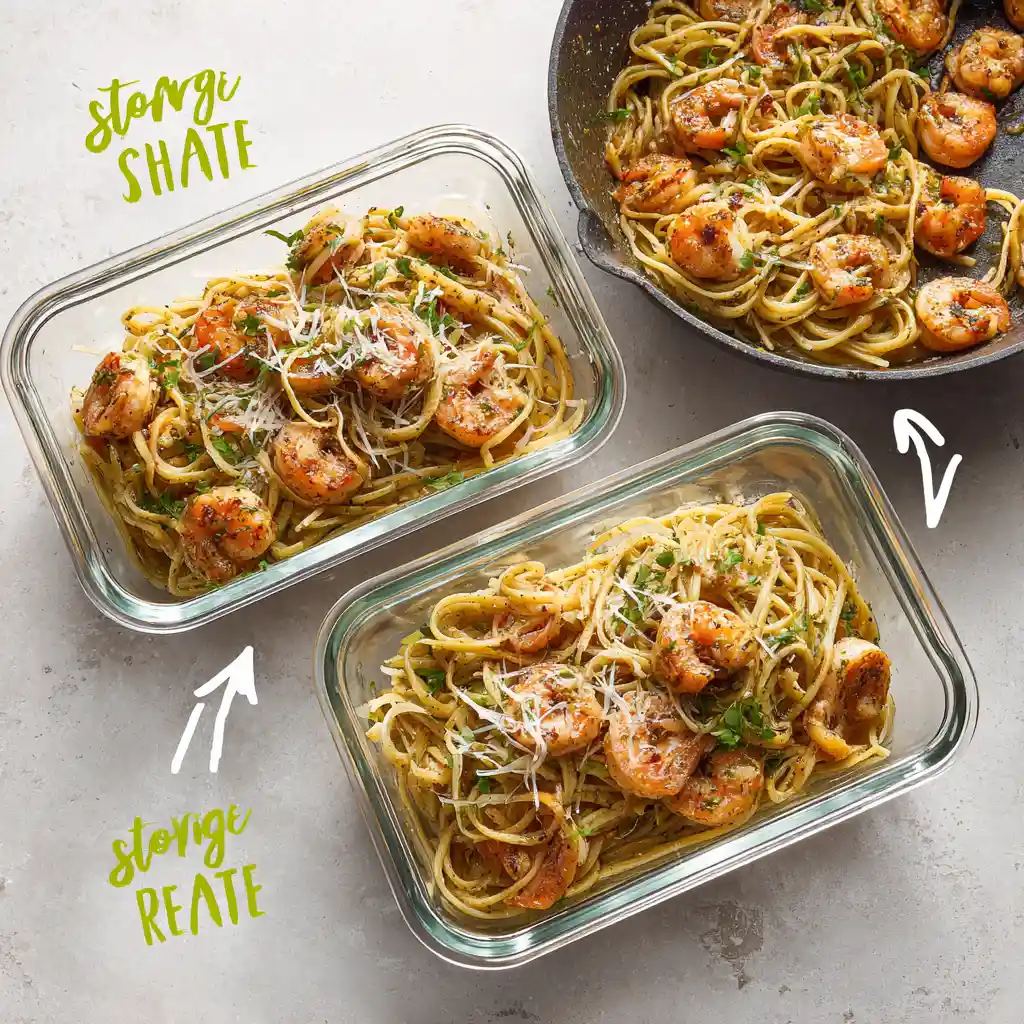
Storage Guidelines
- Cool leftovers promptly within two hours of cooking.
- Transfer pasta and sauce to an airtight container.
- Refrigerate for up to three days.
- For longer storage, freeze the sauce separately for up to two months. Add freshly cooked pasta and shrimp when ready to serve.
Reheating Instructions
Reheat on the stovetop over low to medium heat. Add one to two tablespoons of water or milk and stir continuously until the sauce regains its creamy consistency. Avoid microwaving for long periods, as this can separate the sauce and toughen the shrimp.
Freezer Reheating Option
If frozen, thaw the sauce overnight in the refrigerator. Warm slowly in a saucepan and whisk to restore smoothness. Toss with freshly cooked pasta for best texture.
Safety Tips
Never leave seafood at room temperature for more than two hours. Discard any pasta that smells off or shows discoloration. When reheating, ensure the internal temperature of the shrimp reaches 165°F for safety.
For official guidance on seafood safety and sustainable sourcing, consult NOAA Fisheries. The resource provides valuable information about shrimp harvesting standards and environmental considerations that help you make informed purchasing choices.
If you enjoy practical recipes that store and reheat easily, try the Crock Pot Potatoes or Slow Cooker Country Style Ribs for make-ahead meal solutions.
[Visual suggestion: Overhead image of leftover Cajun Shrimp Pasta in a glass storage container beside a skillet with reheated portion. Include a temperature probe reading for clarity.]
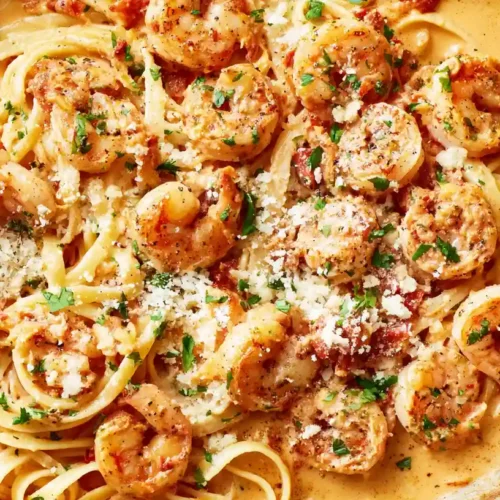
Cajun Shrimp Pasta
Equipment
- Large pot
- Skillet
- Tongs or slotted spoon
- colander
- Grater (for Parmesan)
- cutting board and knife
Ingredients
- 12 oz pasta (penne or fettuccine), uncooked
- 1 lb large shrimp, peeled and deveined
- 2 tbsp butter
- 1 tbsp olive oil
- 1.5 tsp Cajun seasoning (plus more to taste)
- 1 pinch salt and black pepper
- 3 cloves garlic, minced
- 1 bell pepper, diced (optional)
- 1 cup heavy cream
- 3/4 cup Parmesan cheese, freshly grated
- 1 cup reserved pasta water (use as needed)
- 1 tbsp fresh lemon juice
- 2 tbsp fresh parsley, chopped
Instructions
- Bring a large pot of salted water to a boil. Cook pasta until al dente per package directions. Reserve 1 cup pasta water before draining.
- Season shrimp with Cajun seasoning, salt, and pepper. Heat butter and olive oil in a skillet over medium-high. Sear shrimp 1–2 minutes per side until pink. Remove and set aside.
- Lower heat to medium. Add minced garlic and diced bell pepper (if using). Sauté for 30 seconds to 1 minute until fragrant.
- Add heavy cream and remaining Cajun seasoning. Stir well and simmer 2–3 minutes until slightly thickened.
- Whisk in Parmesan cheese gradually. Add splashes of reserved pasta water until sauce becomes creamy and smooth.
- Add drained pasta and cooked shrimp. Toss everything together gently to coat evenly. Adjust seasoning to taste.
- Remove from heat. Stir in lemon juice and garnish with fresh parsley. Serve hot.
Notes
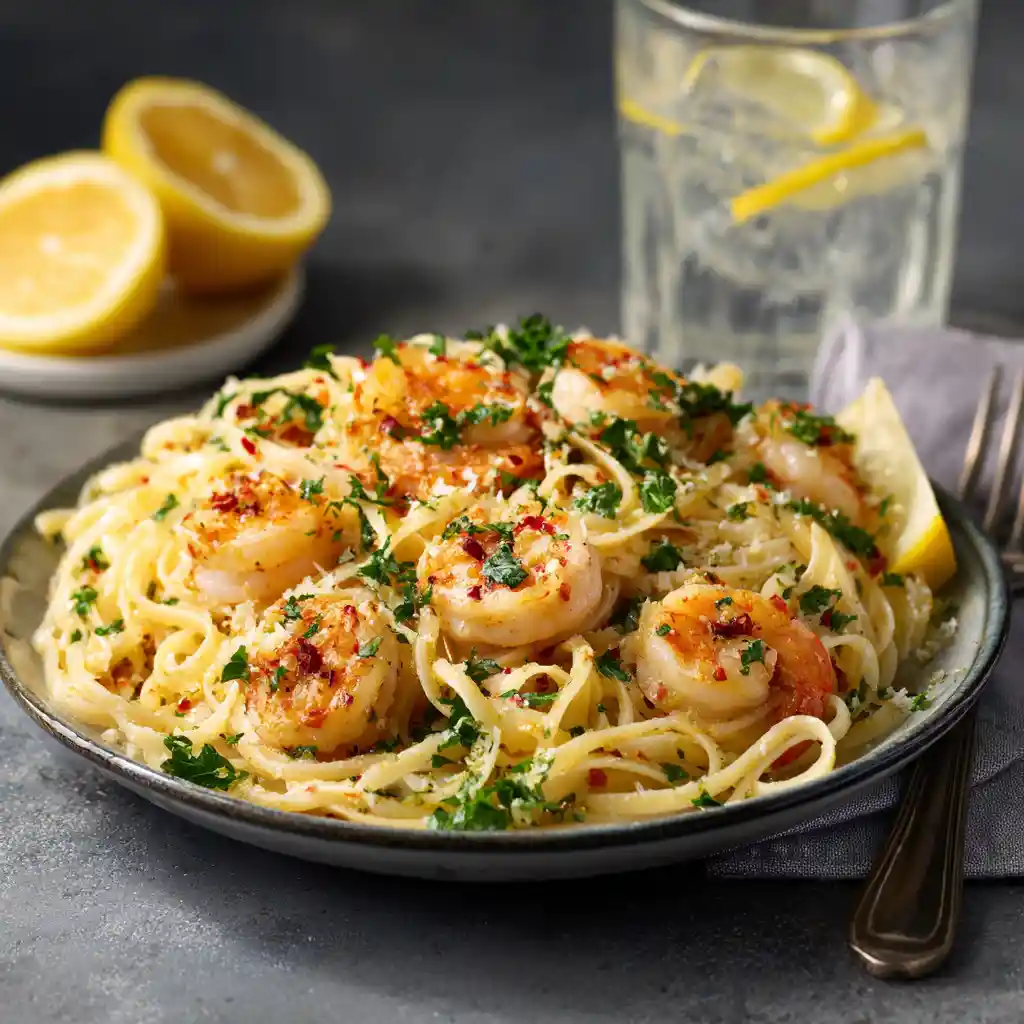
Conclusion
Cajun Shrimp Pasta brings together creamy texture, bold spice, and quick preparation for a dish that feels indulgent yet simple enough for everyday cooking. Whether you prefer the classic version, a smoky sausage variation, or a lighter no-cream alternative, this recipe offers flexibility for every taste and occasion.
By following the detailed steps, you can achieve a balanced sauce that coats the pasta perfectly without splitting or becoming heavy. The 2-Minute Homemade Cajun Seasoning and pairing ideas included here ensure you can recreate restaurant-level flavor in your kitchen anytime.
For a complete meal, combine this pasta with bright side dishes like Mediterranean Chickpea Salad or Greek Yogurt Dressing, and finish with a light dessert such as Lemon Olive Oil Cake. These complementary recipes keep your menu balanced and impressive.
If you’re looking for another satisfying skillet dinner, explore Garlic Butter Chicken Bites or Tex Mex Chicken Rice Skillet. Both share the same easy method and bold flavor approach that defines this Cajun pasta.
Cajun Shrimp Pasta is more than a single recipe – it’s a framework for creative, adaptable cooking that fits any table. Once you try it, it may become the dish you return to most often for comfort, flavor, and reliable success.
[Visual suggestion: Final hero image of Cajun Shrimp Pasta plated with parsley garnish and lemon wedge, surrounded by complementary sides for a complete meal presentation.]
